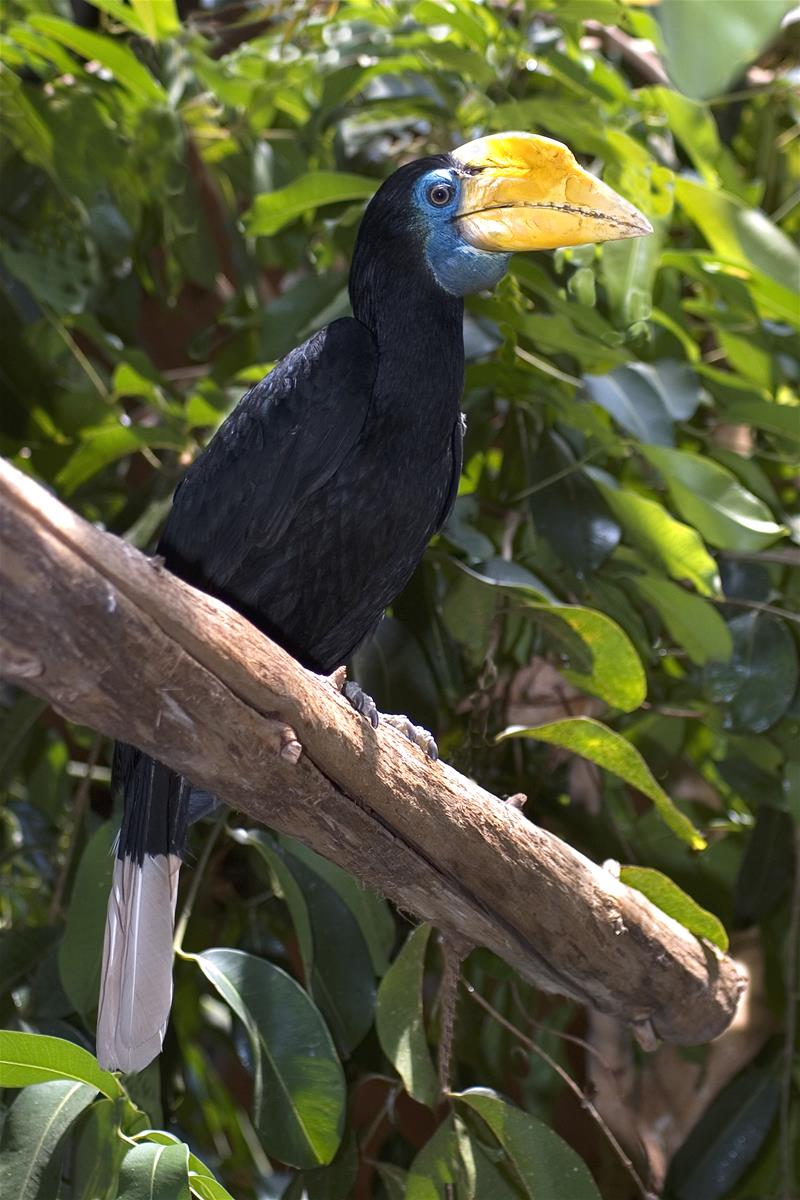Wrinkled hornbill
Aceros corrugatus
Order: Coraciiformes
Family: Bucerotidae
Genus: Aceros
Wrinkled hornbills measure 65-75 cm in height; the male weighing approximately 1600 g. They have black plumage and a white tail with a black base. The white areas are often stained yellow-ochre to red-brown with preen oil. Males have yellow feathering on their inflatable throats, chest, and face. Blue skin covers the eye area. Females do not have yellow colouring on their chest or face but have blue skin covering the face and throat area. Their bills are very large and yellow with a casque on top of the bill. The casque is curved showing ridges (wrinkles). The male’s casque is usually red or orange; the female’s is somewhat smaller and yellow in colour. Eyes are red, while legs and feet are blue-gray.
Distribution
The wrinkled hornbill can be found in south Thailand, peninsular Malaysia, Sumatra (including the islands of Rupat and Payong), the Batu islands, Borneo and were recently recorded in southwest Cambodia.
Habitat
This species inhabits lowland primary evergreen forests as well as coastal swamp forests up to an altitude of 1,000 metres. The distribution of the hornbills can be correlated with the characteristics of forests with large trees that have natural tree cavities used for nesting and plenty of fig trees for food. It can persist in selectively logged forests if primary forests are adjacent.
Diet
They eat mostly fruit; a variety of lipid rich drupes (fleshy fruit with a hard pit) and fine seed fruit such as figs. Figs are favoured. They also consume small animals including frogs, lizards, snails, arthropods, and young birds. During the nesting period when the male is the food provider if he returns with the same food the female will send him on his way to find something else.
Reproduction
Breeding occurs usually during the rainy season of December and January. Nests in cavities of trees are located 40-50 metres above ground. The female seals the entrance to the nest from the inside with a plaster made from mud, droppings, and regurgitated food. The purpose of this is to protect the eggs from monkeys and snakes. A small opening is left for feeding the female and chicks by the attentive male. After a pre-laying period of four to six days, the female will lay an average of two eggs. If for any reason the clutch fails she will lay additional eggs. After a month of incubation, the chicks will hatch. Their skin is pink, which will turn to dark purple in about 10 days. The male feeds both the female and chicks by regurgitation. The female breaks out of the nest when the chicks fledge but the male continues feeding the chicks that remain in the nest. The chicks mature and leave the nest in about 65-73 days; the whole cycle takes about from 111-124 days. After first emerging the chicks take a day or two of exercising their muscles before they can keep up with their parents in flight. Parents continue to feed the juveniles as they forage together in the forests, until they eventually feed on their own. The juveniles resemble the adult male but with a smaller bill and no casque. The adult pair returns to the nest in the next breeding season, leaving immature and unpaired birds to roam among fruiting trees.
Adaptation
They are monogamous, forming lifelong relationships, similar to marriage. Because the female depends so much on the male to provide food for her and her nestlings, courtship occurs throughout the year to build and maintain strong pair bonds. Hornbills get their name from their unique bill. They use it to toss food into the air to eat. The bill is also used to build and maintain nests and in defense against predators such as snakes. The bill is very powerful because it is fused to the cranium, which in turn articulates with the fused upper vertebrae. This creates a pick-ax like beak, very useful to peck out of the nest. In the tropics, food resources vary with space and time. Fruiting trees can be far apart. As a result they are nomadic, covering large areas between foraging areas and roosts. Hornbills are often heard before seen. They have deep echoing calls sounding like a harsh “kak-kak” or a deeper “rowwow”. Their calls can be heard from a large distance.
Threats to Survival
The biggest threat is logging, which results in loss of habitat and also loss of suitable nesting sites. In some areas they are still hunted for their tail feathers, used to adorn traditional costumes.














